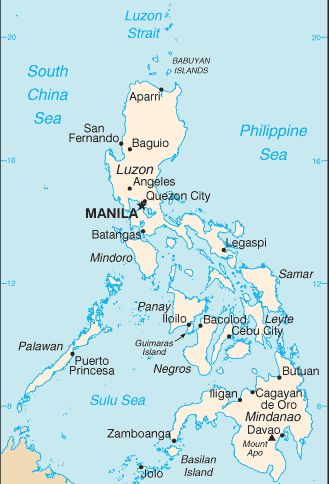|
PHILIPPINES
|
|
|
|
|
|
|
|
During the six-year term of President Mr. Benigno Aquino III (2010–2016), the Philippines became one of the region’s best-performing economies. Now, the question is whether his successor, longtime Mayor of Davao City Rodrigo Duterte, will maintain and expand his predecessor’s successful policies. While agriculture is still a significant part of the economy, industrial production in areas like electronics, apparel, and shipbuilding has been growing rapidly. Remittances from overseas workers are equivalent to nearly 10 percent of GDP.
Benigno AQUINO III was elected to a six-year term as President in May 2010 and was succeeded by Rodrigo DUTERTE in May 2016.
Trade is important to the Philippines’ economy; the value of exports and imports taken together equals 61 percent of GDP. The average applied tariff rate is 4.3 percent. Many agricultural imports face additional barriers. Investment in several economic sectors is restricted. The financial sector remains relatively stable and sound. In 2016, the central bank announced that it would end a 17-year moratorium on the granting of new banking licenses.
At a Glance
|
Country Name
|
Republic of the Philippines
|
|
Area
|
2,99,404 sq.km
|
|
Capital
|
Manila
|
|
Government type
|
Presidential Republic
|
|
Administrative divisions
|
80 provinces and 39 chartered cities
|
|
National Holidays
|
Independence Day, 12 June and 4 July
|
|
Fiscal year
|
Calendar Year
|
|
Currency
|
Peso (PHP)
|
|
President
|
Rodrigo DUTERTE (since 30 June 2016)
|
|
Population
|
104,256,076 (July 2017 est.)
|
|
Net migration rate
|
-2 migrant(s)/1,000 populations (2017 est.)
|
|
GDP (purchasing power parity)
|
$805.2 billion (2016 est.)
|
|
GDP- composition by sector
|
Agriculture:9.7%
Industry: 30.9 %
Services: 59.5 % (2016 est.)
|
|
Agriculture- Products
|
Rice, fish, livestock, poultry, bananas, coconut/copra, corn, sugarcane, mangoes, pineapple, cassava
|
|
Industries
|
Semiconductors and electronics assembly, food and beverage manufacturing, construction, electric/gas/water supply, chemical products, radio/television/communications equipment and apparatus, petroleum and fuel, textile and garments, non-metallic minerals, basic metal industries, transport equipment
|
|
Major Exports
|
Semiconductors and electronic products, machinery and transport equipment, wood manufactures, chemicals, processed food and beverages, garments, coconut oil, copper concentrates, seafood, bananas/fruits
|
|
Major Exports - Partners
|
Japan 21.1%, US 15%, China 10.9%, Hong Kong 10.6%, Singapore 6.2%, Germany 4.5%, South Korea 4.3% (2015)
|
|
Major Imports
|
Electronic products, mineral fuels, machinery and transport equipment, iron and steel, textile fabrics, grains, chemicals, plastic
|
|
Major Importers - Partners
|
China 16.2%, US 10.8%, Japan 9.6%, Singapore 7%, South Korea 6.5%, Thailand 6.4%, Malaysia 4.8%, Indonesia 4.4% (2015)
|
|
Natural resources
|
Timber, petroleum, nickel, cobalt, silver, gold, salt, copper
|
|
Languages
|
Filipino (official; based on Tagalog) and English (official); eight major dialects - Tagalog, Cebuano, Ilocano, Hiligaynon or Ilonggo, Bicol, Waray, Pampango, and Pangasinan
|
|
Ethnic groups
|
Tagalog 28.1%, Cebuano 13.1%, Ilocano 9%, Bisaya/Binisaya 7.6%, Hiligaynon Ilonggo 7.5%, Bikol 6%, Waray 3.4%, other 25.3% (2000 census)
|
|
Climate
|
Tropical marine; northeast monsoon (November to April); southwest monsoon (May to October)
|
|
Location
|
Southeastern Asia, archipelago between the Philippine Sea and the South China Sea, east of Vietnam
|

